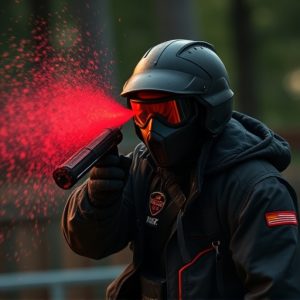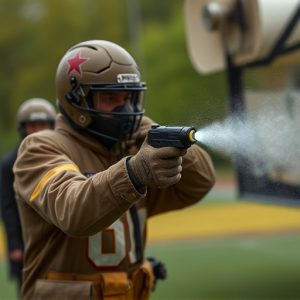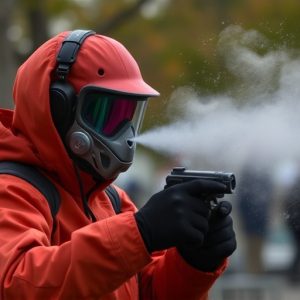Decoding Pepper Spray’s Power: Its Effectiveness and Selection for Self-Defense
Pepper spray is a non-lethal self-defense tool containing oleoresin capsaicinoid (ORC) that tempora…….
Pepper spray is a non-lethal self-defense tool containing oleoresin capsaicinoid (ORC) that temporarily incapacitates attackers by causing intense pain and irritation upon contact with the eyes or skin. Its effects, which last between 15 to 45 minutes, are due to the active ingredient binding to pain receptors, leading to reflexive reactions like eye closure, temporary 'blinding' of vision, and significant pain comparable to touching fresh chili peppers. This brief window provides a crucial opportunity for escape or assistance. While pepper spray does not cause blindness permanently, its use requires understanding the environmental and individual sensitivity factors that can affect its potency. Users should be well-trained in its application, as the concentration of OC, spray pattern, canister size, and legal compliance are all critical to effective self-defense. Proper education is essential to ensure pepper spray is used correctly, for it is a deterrent rather than a definitive solution. A 10% OC minimum is generally advised for potency, with foam or gel sprays often being more precise due to their design. Remember that the effects of pepper spray are not intended to cause permanent damage and can be alleviated with eye flushing and medical care if necessary.
When it comes to personal safety, understanding the tools at your disposal is crucial. Pepper spray, a widely recognized self-defense mechanism, has garnered attention for its effectiveness in non-lethal defense scenarios. Known colloquially as “bear spray” or “mace,” this potent form of self-defense can temporarily incapacitate an assailant. Can pepper spray blind you? While it may not cause total vision loss, its intense irritants can significantly impair an attacker’s sight, providing a critical window of opportunity for escape. This article delves into the impact of pepper spray, the science behind its effects on vision, and how to select the most suitable self-defense spray for your safety needs.
Understanding the Impact of Pepper Spray: Can It Blind an Attacker?
Pepper spray, a popular choice for personal defense, is often understood to have a potent visual impairing effect on attackers. The active ingredient in pepper sprays, capsaicinoid, is derived from chili peppers and can cause intense irritation upon contact with the eyes, skin, or respiratory system. When discharged effectively, it can temporarily render an assailant unable to see, as the capsaicinoids stimulate the trigeminal nerves that activate tear ducts and eyelids to close reflexively in an attempt to flush out the irritant. This physical response can significantly hinder an attacker’s ability to see, effectively creating a temporary blindness that buys valuable time for the defender to escape or seek help. However, it’s important to note that while pepper spray can cause significant discomfort and impair vision, it does not ‘blind’ someone in the permanent sense. The effects are typically short-lived, usually lasting between 15 to 45 minutes, depending on factors such as wind conditions, the strength of the spray, and individual sensitivity. Users should be well-versed in the proper use of pepper spray to maximize its effectiveness and understand its limitations, as it serves as a non-lethal deterrent rather than a definitive solution for self-defense.
The Science Behind Pepper Spray and Its Effects on Vision
Pepper spray, a common self-defense tool, is a form of non-lethal chemical repellent used to temporarily incapacitate an attacker. Its primary active ingredient, oleoresin capsaicinoid (ORC), derived from natural chili peppers, causes intense irritation upon contact with the eyes, skin, or respiratory system. When deployed, the fine mist of pepper spray penetrates the eyes, triggering a reflexive response to close them tightly, which traps the spray against the cornea and conjunctiva. The capsaicin in the spray binds with pain receptors in the nerve endings of these tissues, sending strong signals to the brain that are interpreted as extreme pain, effectively immobilizing the attacker by rendering them unable to see clearly or continue their aggression for a significant period, typically 30 to 45 minutes. The intensity of the effects is comparable to what one would experience if they were exposed to concentrated capsaicin directly from fresh chili peppers, just on a much smaller scale due to the dilution in the spray.
The science behind pepper spray’s effects on vision is rooted in its interaction with the sensory neurons that detect pain and temperature in the eyes. The eyes contain various receptors, including TRPV1 receptors, which are highly sensitive to capsaicin. Upon exposure to the irritant, these receptors activate a cascade of neural signals that the brain interprets as unbearable pain, leading to the sensation of burning and an overwhelming urge to flush the eyes with water. The inflammatory response caused by the pepper spray can also lead to swelling of the eyelids and conjunctiva, further impairing vision. It’s important to note that while pepper spray can temporarily blind an attacker, it is not designed to cause permanent blindness. Its effects are reversible upon thorough flushing with water and appropriate medical attention if necessary. Understanding the science behind its operation ensures users of pepper spray can effectively use this tool for personal defense without causing undue harm.
Choosing the Right Self-Defense Spray: Factors to Consider for Personal Safety
When considering a self-defense strategy, a self-defense spray can be an effective non-lethal tool for personal safety. Selecting the right pepper spray is crucial for its effectiveness in potentially dangerous situations. One primary factor to consider is the strength of the spray; the concentration of oleoresin capsicum (OC) determines its potency. A higher concentration typically causes more intense irritation, which can effectively incapacitate an assailant. It’s often recommended that the spray has at least a 10% OC solution for effectiveness. Another important aspect is the spray pattern; options like foam or gel can be easier to aim and control than liquid sprays, reducing the risk of accidental deployment. Additionally, the canister’s size and the number of bursts it provides should align with your needs. For instance, a smaller canister might be more concealable but may require reloading during an altercation. Understanding the legal restrictions and regulations regarding pepper spray in your area is also essential, as laws vary by state or country. Lastly, considering personal factors such as your ability to deploy the spray accurately under stress and any specific health conditions that might affect its use is important for ensuring your safety. Can pepper spray blind you? While it won’t cause permanent blindness, its effects can be debilitating, causing intense pain and temporary blindness. This gives you a critical window of time to escape from an attacker. Always ensure that you are well-informed about the specific product you choose, including its active ingredient concentration, spray pattern, and legal compliance, to effectively use it as part of your personal safety plan.


